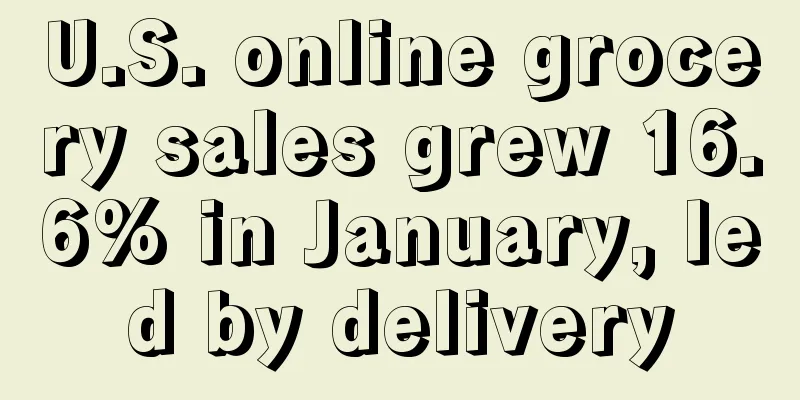U.S. online grocery sales grew 16.6% in January, led by delivery

|
It is learned that on February 11, according to foreign media reports, US online grocery sales continued to maintain strong growth in January, reaching 10 billion US dollars, a year-on-year increase of 16.6%. This growth momentum has continued for six months, mainly benefiting from the substantial discounts provided by membership and subscription plans. According to the latest report from Brick Meets Click/Mercatus, all three major delivery methods achieved year-on-year growth. Among them, the delivery method performed the best, with a sharp increase of 37% to US$4.1 billion. Since mid-2024, the delivery model has continued to benefit from membership and subscription discounts, which has led to a significant increase in monthly active users, a significant increase in order frequency, and a slight increase in average order value. This growth trend has increased the market share of the delivery method by 610 basis points compared with the same period last year, and as of the end of January, its share of online grocery sales reached 41%. Self-pickup sales also increased, but the increase was relatively small, up 4% year-on-year to $4.2 billion. Although the average order value has increased, the number of monthly active users and order frequency have both declined. Analysis pointed out that the slowdown in the self-pickup business was mainly affected by promotional activities, as consumers tend to choose discounted delivery services. As of the end of January, the market share of self-pickup fell by 500 basis points to 42%, but it was still slightly higher than the delivery model. Meanwhile, home delivery sales increased 9% year-over-year to $1.6 billion. Despite a decline in average order value, growth in monthly active users and increased order frequency drove overall sales. However, home delivery's relatively low growth compared to delivery and pickup led to a 110 basis point year-over-year decline in its market share to 16% at the end of January. David Bishop, partner at Brick Meets Click, pointed out that the rapid growth of the delivery model is mainly driven by large retailers such as Walmart. The continuous promotion strategy not only effectively increases consumers' purchase frequency and spending, but also improves user retention and market share, which is expected to intensify industry competition and make other retailers face greater challenges in the future. Despite the significant growth in online grocery sales, total spending in the overall U.S. grocery market only increased by 2.5% year-on-year. Against this backdrop, the market share of online sales increased to 15%, up 180 basis points from the same period last year. This trend shows that consumers are accelerating their shift to online channels, and membership discounts and convenience remain key factors driving the growth of online groceries. Author ✎Rayna/ Statement: This article is copyrighted and may not be reproduced without permission. If you need authorization, please contact: happy |
Recommend
Amazon settles accounts! Stores that violate regulations are closed directly|Cross-border headlines of the week
Platform Knows 0 1 Amazon's big overhaul! Vio...
Recruitment demand surges 324%! TikTok training institutions make a fortune, and sellers are long gone?
Get the "2022 Cross-border E-commerce Annual ...
What is XYyuke? XYyuke Review
XYyuke is an Amazon product management tool. Categ...
What is Jackmall? Jackmall Review
Jackmall is a cross-border new retail distribution...
What is WhatsApp? WhatsApp Review
WhatsApp is a very popular cross-platform applicat...
Amazon TM label chasing and selling
First of all, sellers should improve their awaren...
Urgent! If you don’t upload this type of file before November 9, your product will be removed from the shelves! A large number of sellers have been affected!
Yesterday, just as everyone was immersed in the jo...
Is American purchasing power at risk? Credit card debt hits new high, delinquency rates climb
According to data from the New York Federal Reserv...
What is Haitu Cross-border? Haitu Cross-border Review
Haitu Cross-border focuses on one-stop Amazon oper...
Best Buy's Q3 revenue is $9.45 billion, and it lowers its full-year performance forecast
It is learned that on November 26, the US retail g...
Children's clothing consumption survey: 80% of parents discover new products through platforms such as TikTok
It is learned that on October 10, according to for...
What is Russian Best Choice? Russian Best Choice Review
Harbin Rufavor E-commerce Co., Ltd. (Rufavor) is a...
Amazon HD Image Tool Cutout
Website: https://www.cutout.pro/ 3S makes blurry ...
The seller was fired for opening a private store! Will all operations go solo?
▶ Video account attention cross-border navigation ...
Tool recommendation: These screen recording software are both free and easy to use
What screen recording software is both free and e...









